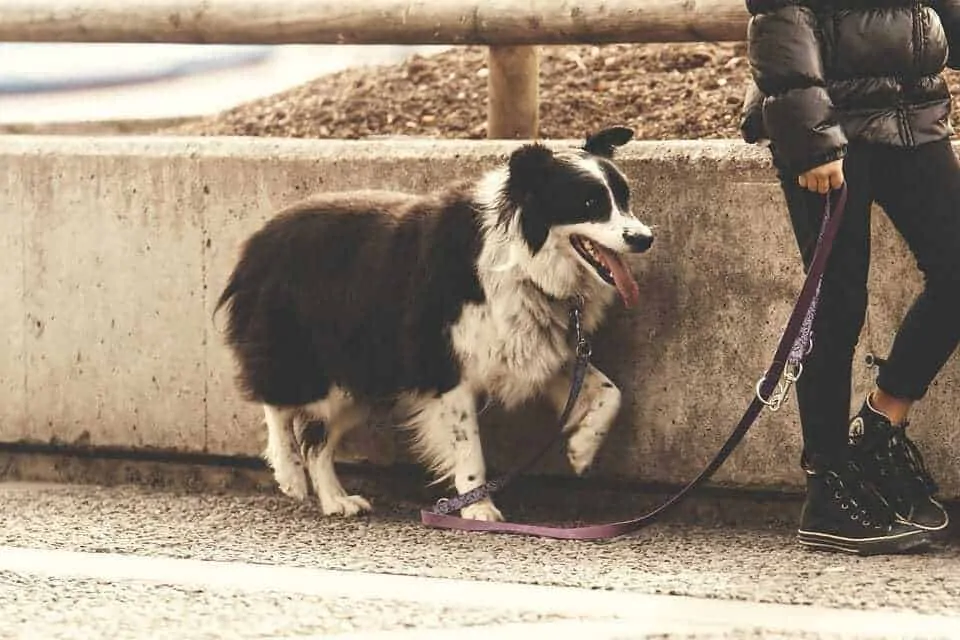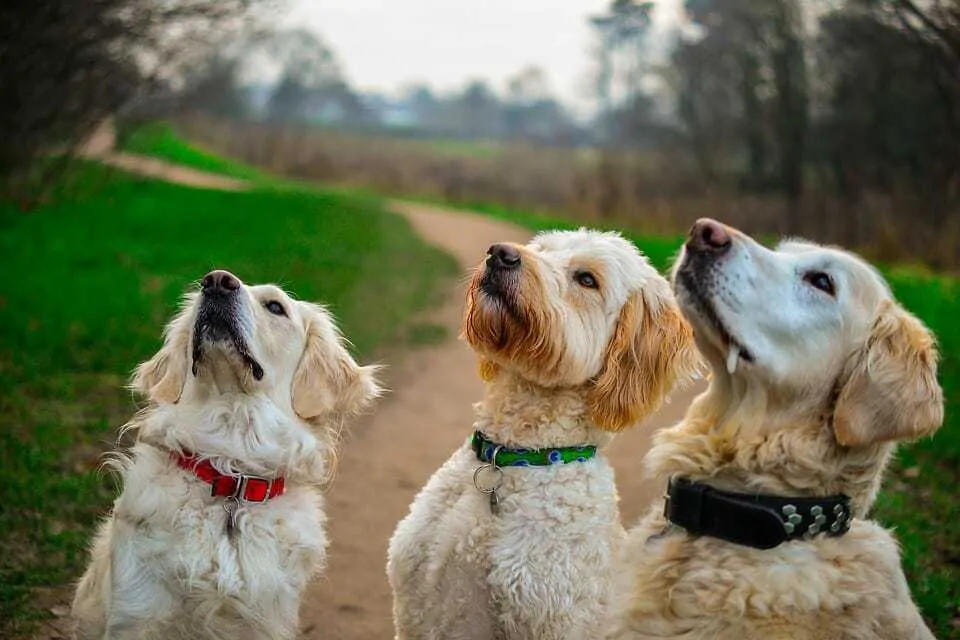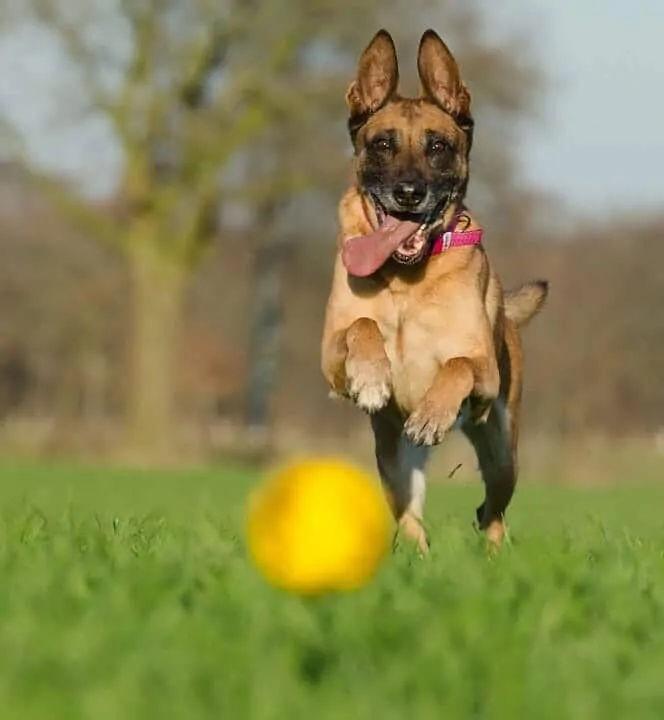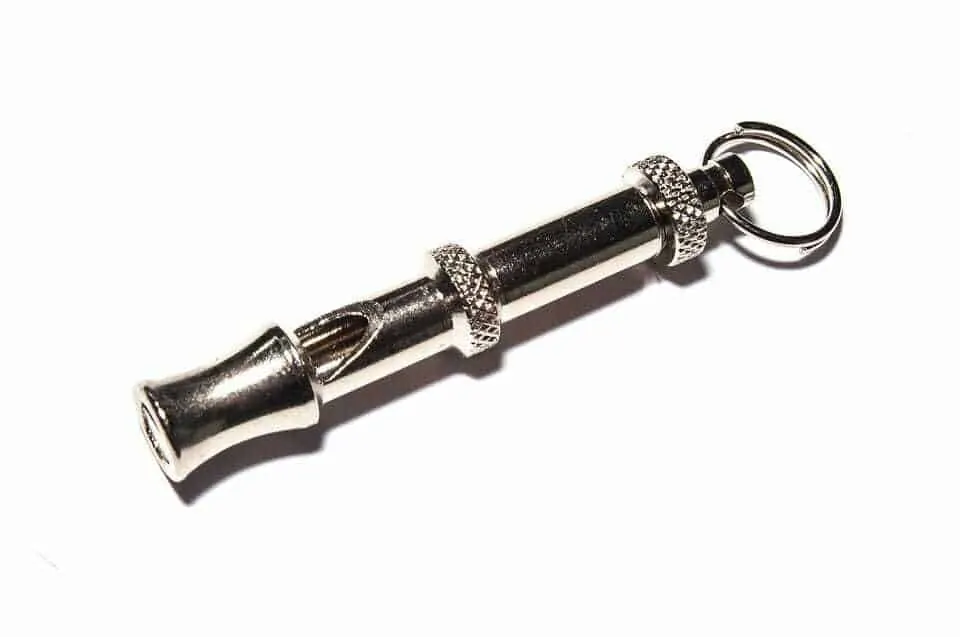Looking for the best dog training equipment? Even if you have the most well-behaved dog on the planet, it can benefit them to have some basic training. Not only can it be great brain food, helping them to stay stimulated and entertained, but it can also greatly increase the bond between you and your dog.
For those just starting out on their training journey, there are a number of simple, inexpensive dog training equipment that you should consider investing in and some that we would recommend that you steer clear of too. We have pulled together a helpful little list of dog training equipment along with some recommended high quality dog training equipment brands too.
Contents
A Clicker
This little, very inexpensive gadget is a surprisingly powerful and helpful piece of training equipment to have in your dog training equipment arsenal.
A clicker allows you to clearly mark the desired behaviour offered by your dog by making a “click” followed by a reward (normally a tasty treat). Your dog will quickly start to understand that not only do they receive a treat every time the click comes but they also know that this means they have done something that you are happy with and they will offer the behaviour again more readily as a result. Simple, effective, fun and fair.
We would always recommend having a spare clicker around as they are small and easy to lose and investing in a wrist coil can save them from being misplaced and keeps them easy to access when you are working on a quick-fire training session.
There are lots of clickers on the market and everyone has their own favourite in terms of ease of use, the sound of the click and even design and color choices. You can’t really go wrong with the best-selling I-Click, developed by renowned Clicker Trainer Karen Pryor. It is compact, the click is clear but not overbearing, it is a functional shape, inexpensive and available in a selection of colours. Make sure you are buying the real deal though as there are lots of imitations and they don’t all work as well.
See our Clicker Training article for more in-depth details on how this training technique works.
[amazon box=”B002LAS2KW” style=”light” title=”I-Click” template=”widget” ]
Adjustable Training Leash
An adjustable training leash doesn’t just have to be for use in training sessions, it can actually be a great piece of training equipment for use as an everyday leash too.
The leash can usually be set to at least three different lengths and this gives you great freedom when you are working on perfecting loose leash walking, working on short distance work, need to have control over a reactive or excitable dog in certain situations or are working near traffic.
My favourite is the Halti Training Leash by the Company of Animals. It is reasonably priced, durable, comfortable, easy to adjust, available in two widths depending on the size of your dog and I have yet to have any complaints. It is only available in black or red though, so for the stylish dog owners out there that like an option that will match with outfits or collars and harnesses, this may not be your favourite choice!
The leash is not just useful for training but also for lots of other situations. It can be used as a hands-free leash option by wrapping around your waist, it can be used to temporarily secure your dog if you are eating in a cafe or having a picnic by wrapping around a secure table leg or tree and it could even be used as an emergency coupler for walking two dogs if one lead breaks.
An adjustable length training leash is great as an everyday leash and also for teaching loose leash walking.
A Long Line
If you are building up to letting your dog off leash and need to have a safety net whilst working on a perfect recall then a long line is an essential training tool.
If your dog’s recall is not reliable, the more opportunity they have to run off and have fun elsewhere without you being able to get them back quickly, the more rewarding they will find this and the less successful your recall training will be.
While you work on teaching your dog that every time they voluntarily come back to you when you call that they get something they really love (super duper yummy treats or a game with their favourite tug toy, for example), it is useful to have a backup in the long line. It means that you can let them move away from you to a significant distance before calling them back and you also know that they can’t run off and cause any havoc.
It can also be a useful piece of training equipment if your dog is generally good off-leash but is not so good in areas where there are lots of temptations (perhaps a park where there are lots of picnics around or in a forest where there is lots of wildlife to chase). It can give your dog an opportunity to get a bit more freedom and a chance to run without you having to worry about them being too mischievous.
The Company of Animals Long Line is a great option It is available in two sizes, 5 metres and 10 metres long. Unless you have a very large, open space to work in, we would recommend sticking with the 5-metre length to avoid getting it tangled too easily. They are lightweight, soft and don’t have a handle loop, making them safer for trailing on the ground.
NEVER use a long line when your dog is just on a collar. If your dog runs at full speed to the end of the long line the impact that this can put directly on the neck can be extremely dangerous. Always use a harness so that this distributes any pressure over a sturdier part of the body.
Also, be very careful when there are other dogs or children around as it can be easy to get caught up in the line when it is trailing.
[amazon box=”B004R173F8″ style=”light” title=”Company of Animals Long Line” template=”widget” ]
Yummy Dog Treats
NEVER leave the house for a walk without something that is rewarding for your dog. Even if your dog gives you a very reliable recall it is always good practice to continue to reward them sporadically for good behaviour so that they do not get blasé and then start to become unreliable because they are not anticipating anything good.
It is always good to pick something that your dog finds really delicious for rewarding them for good behaviour in a distracting environment.
Don’t forget to vary the treats you are offering too, to keep it interesting. Every dog is different in terms of what they will work for. Our guide to good training treats may be a useful starting point.
To get focus like this you need to pick super tasty treats as a reward when training
Engaging Toys
Some dogs find toys more motivating than treats, or perhaps you can keep them more engaged with a mixture of both.
Again, it is all about finding out what motivates your dog most. Some dogs absolutely a game of tug-of-war, some love a squeaky tennis ball, some love a frisbee. If you can, always carry two toys, just in case.
Your goal is to make you more rewarding and interesting than anything else and for them to LOVE whatever reward you are giving them so that they will want to continue to work for you. If that means a whole heap of squeaky balls then so be it!
Toys can be incredibly rewarding for some dogs. Work out what they like the best and always rotate to avoid them losing interest
Training Treat Pouch
It is really important that when your dog does something that you have asked of them that you are able to give them a reward for this very quickly. If you wait too long they will not associate the reward with the behaviour that you were looking for.
Having a good quality treat pouch can make treat delivery a lot easier. It also means that you can avoid having smelly and greasy trouser or coat pockets.
There is a whole selection of treat pouches on the market, some better than others.
It is good to make sure that it has a good quality inner that is easily wiped down. A pouch that has easy access is also good, if you have to fiddle about with an opening this defeats the purpose. One that attaches easily is also useful. It can be good to select one that attaches by an adjustable belt around the waist.
One variety of treat pouch that gets consistently good reviews is The Rapid Rewards Treat Pouch from Doggone Good. It has a super useful magnetic closure, separate pockets for poop bags, mobile phones and keys and an adjustable belt strap for around the waist. It also has a good reputation for being robust and withstanding regular use.
[amazon box=”B017V679X6″ style=”light” title=”Doggone Good Treat Pouch” template=”widget” ]
An Appropriate Collar or Harness
It is really important when you are doing any training session that your dog is comfortable, safe and secure.
We are fans of using harnesses for any walk but, if you are opting for a collar make sure that it fits well and that is a good quality flat collar. If you are working on exercises at speed, you are using a long line, you have a dog with respiratory issues, they are a flat faced breed like a Pug or a French Bulldog or they have a thin neck like a Greyhound or Whippet then we would suggest always opting for a harness to minimise any risk of injury or breathing problems.
There are lots of really good harnesses on the market but we are great fans of the Ruffwear Front Range Harness.
[amazon box=”B01N10JGXA” style=”light” title=”Ruffwear Front Range Harness” template=”widget” ]
Dog Training Equipment Additions: The Non-Essentials
There are some other training tools that you may have a personal preference towards using or that will be useful in certain circumstances. We have outlined some of these below.
A Whistle
Whistles can be really useful training tools for working on recall over longer distances or in distracting or noisy environments.
There are a whole heap of different options out there and some dogs will respond to certain tones more than others. The key though is to make sure that your dog knows that every time they hear the peep of that specific whistle, good things will follow.
You should start in a closed environment where there are minimal distractions and every time you blow the whistle you give your dog a yummy treat. This should be repeated for a number of short sessions over the course of a few days before progressing on to a more distracting environment. If you are using it for recall training, still make sure you start in an enclosed space outside or use a long line before progressing to letting your dog off the lead. The same principles apply outside, every time your dog returns to you at the peep of the whistle, they are heavily rewarded.
There are lots of different styles of whistle out there and they can all work effectively if you introduce them properly. Some of the most popular are the gun dog style whistles from Acme. They come in a variety of pitches and some dogs will tune into a particular pitch more keenly than another. There are also whistles which can be adjusted to change the pitch and ones that are not so loud for us humans but the dog can still tune into the pitch because of their keen sense of hearing. If you do get an adjustable pitch whistle, be careful that it does not unscrew if it is hanging around your neck, leaving you with only a top section.
If you have a two piece whistle like the one above and you have it around your neck, watch out for it unscrewing and leaving you with just the top part!
A Target Stick
If you are getting serious about your training sessions or want to train some specific tricks you may want to invest in a target stick. By using a target stick to direct your dog to touch something specific and then marking the correct behaviour with a click and treat to follow, this can speed up your dog’s comprehension of the specific request you have of them.
Maybe you want to teach them to open a cupboard drawer and you have added a tug toy to the handle. Every time that your dog touches that tug toy, they receive a reward and by using a target stick this can help to give them clear direction. The next stage would be to wait for them to hold the toy, then move onto pulling it and so on.
It can also be useful for working on loose lead walking, especially if you have a small dog. By asking them to follow the target stick and rewarding them whenever they do this, gradually building up the duration, it puts less strain on your back back and again gives your dog a clearer understanding of what is being asked from the start of a training session.
[amazon box=”B0062MEVJ6″ style=”light” title=”Target Stick” template=”widget” ]
A Settle Mat
Having a small, transportable mat that you teach your dog to lie down on when it comes out can be extremely useful for a variety of circumstances. It is great in a training class environment when you want your dog to relax in between sessions. It can be useful for taking to dog-friendly cafes or when visiting friends so that your dog has a place to go, it can also be useful at home too. If you have a dog that gets very excitable when the doorbell rings or when visitors come in., teaching the alternative behaviour of going to their ‘place’ rather than barking or jumping up can be a great exercise to work on. By always using the mat when you ask for them to settle this can then be used in a variety of different circumstances and environments.
Obviously, you need to introduce the mat gradually and build up the duration of their settles slowly and always have super yummy treats to hand, or for longer settles, you could even give them a chew or treat toy to keep them rewarded and occupied.
Choose something that is big enough for your dog but easy enough to transport, wash and that will not slip around on certain surfaces. A lot of people opt for a good quality pet runner or, for smaller dogs, a non-slip doormat can work too.
A Dog Crate
Dog Crates can be very useful training tools in the right circumstances. They should NEVER be used as a place to put your dog as a punishment. This will backfire quickly with your dog dreading being stuck in the crate and often not even understanding why and potentially battling to get out or fighting when going in.
Instead, they should be made into a cozy, secure den space that your dog enjoys going into to settle and relax. It is very important that they are introduced slowly and in a very positive fashion. Crate training can take time to build up.
If introduced properly you can use a crate to ask for a settle and encourage your dog to be in there if you have visitors, for sleeping in through the night or to help whilst you are working on toilet training. If you are leaving a puppy for a short while unsupervised they can be safe, secure and not have access to dangerous things to chew on whilst they are in there. It can also be great for keeping them safe and secure in a car or when you have a multi-dog household and they need some space of their own.
Make sure that the crate is big enough, is comfortable with appropriate bedding, that your dog is comfortable being inside it and that you are not leaving them in it for prolonged periods. They still need plenty of exercise and interaction.
If you are using a crate, make sure it is the right size, made comfortable and that you introduce it alongside lots of positive treats, toys and chews
Baby Gates or Other Barriers
Baby gates, puppy pens and other temporary barriers can be very useful in a variety of circumstances. If you have children and you want to keep your dog/s and them separate whilst you are not there to supervise this can be a great management tool. They can also be useful whilst you are working on training in a multi-dog or dog and cat household, particularly if there have been scuffles between your dogs. It can be a good extra precaution whilst you are building up introductions. They are often used to create a barrier when feeding, especially if any dogs have exhibited resource guarding issues. Whilst it is always good to address any serious behaviour concerns, having these barriers can be a great backup management tool and sometimes it is appropriate for them to be a long term solution too.
Safe Chews or Treat Toys
Using longer lasting, safe chews or stuffed treat toys can also be a useful training tool. If you want to teach your dog to settle whilst you are having dinner, when you have guests visiting, whilst you are crate training, or in a whole host of other possible situations, then giving them a yummy longer lasting option to keep them busy for a while whilst also asking for a “settle” command can be extremely useful.
Make sure that whatever you are giving them is not going to present any choking hazard and that it is something that they really enjoy. Stuffed Kong toys are always very popular or, if you want to give them something edible, why not opt for a Bully Stick, if you are not too squeamish!
[amazon box=”B0002AR0HO” style=”light” title=”Classic Kong Dog Toy” template=”widget” ]
Calming Aids
If you have a fearful dog or one that gets anxious very easily, it is important to develop a training plan to help ease their anxieties and make them feel more relaxed around whatever their triggers are. If a dog is extremely anxious, sometimes this can make it difficult for them to be receptive to the training. You often have to start with very, very gradual introductions that are done over short, frequent sessions building up the frequency and always in conjunction with lots of positive reinforcement. Sometimes using calming aids can help to take the edge of your dog’s anxiety, making them a little more receptive when the training begins.
Some popular calming aids include:
A Thundershirt– this is a tight fitting t-shirt which applies pressure across certain parts of the body. This is designed to create a swaddling type effect that can sometimes sooth your dog and help them to feel a little more comforted.
An ADAPTIL collar or spray – Dog Appeasing Pheromones (DAP) are a synthetic scent that is designed to mimic those given off by the mother to comfort her puppies. Again these can help to take the edge off any anxieties.
These are never normally a solution on their own but they can be a useful addition to your training armoury when you have an anxious dog.
When dealing with extreme anxiety issues we would always recommend consulting with a reputable and fully qualified dog behaviourist for some advice on helping your dog to be more relaxed.
[amazon box=”B003YYLY0O” style=”light” title=”Thundershirt for Dogs” template=”widget” ]
Good Training Books
Whilst it is great to have all the bits of kit that will help you move towards successful training with your dog, if you don’t know how to use them or use them incorrectly it can actually sometimes cause more damage than good. It is always important to make sure that you are well armed with the knowledge of how to apply the techniques. Investing in a couple of really good training books can be well worth the money.
Always make sure that you select a book that promotes positive, science-based training techniques and is written by a respected, qualified author in the field.
We have an article with a great list of suggested books that you can invest in, for all sorts of specific training areas.
If you are looking for an all-round general training book recommendation then we would suggest ‘The Power of Positive Dog Training’ by Pat Miller or ‘Decoding Your Dog: Explaining Common Dog Behaviors and How to Prevent or Change Unwanted Ones’ produced by the American College Of Veterinary Behaviorists as being a couple of good starter options.
Training Classes or One-To-Ones
Books can be fantastic resources but sometimes, particularly if you are a new dog owner or if you are dealing with a particularly challenging behaviour, it can be extremely useful to get some direct expert guidance. Not only can it boost your confidence that you are moving in the right direction but it can also provide you with additional guidance you might not have read about in a book and you can get some feedback on things you may not be applying correctly.
Classes can be great for general training but for serious issues or if you have a dog that is nervous or reactive in a group environment then opting to get some private consultations would likely be more beneficial.
As we always say, it is important to ensure that you look for a well respected, well -qualified dog trainer or behaviourist that promotes the use of positive training techniques.
Training classes can be great for new dog owners and for learning a specific skill, like agility
Dog Training Equipment You Should NOT Invest In
There are LOTS of training gadgets and gizmos on the doggy market. You can find all kinds of dog training equipment if you look hard enough. Many offer what seems to be like great quick fix solutions. Quick fixes can often backfire dramatically and we would always recommend putting the work in. You will see longer lasting, more effective results and it will also result in a stronger bond between you and your dog. Many of the quick fixes out there rely on aversives, your dog receives a punishment for doing something you don’t want, and this often is in the form of pain.
Not only is it unfair to use a painful technique to train your dog but often the pain can make your dog lash out aggressively eventually when they have had enough. Sometimes they will just completely shut down at first, too afraid and unable to do anything else. This is not actually dealing with the problem though and surely it is fairer for your dog to work with them in a positive fashion and one that does not rely on you only having success because they are frightened or in pain?
Some of the training tools that are on our list of NON recommended dog training equipment include:
Shock Collars
This is probably the most controversial dog training equipment of them all. A Shock Collar is usually remotely operated and works by administering a shock to your dog whenever they do something you do not want them to. Yes, they can often stop your dog from doing the undesired behaviour but this is done through something that can be extremely painful.
When used frequently, some dog’s can start to become desensitised to the pain and so the owner has to keep turning up the ferocity of the shock to get the reaction that they want. This can result in horrific injuries as the force of the shock is too strong.
Some dogs can also start to exhibit more aggressive behaviour as a result of the pain they are in when they are being shocked. In certain cases, it can create more problem behaviours.
Many dogs will continue to display the behaviour when they do not have the collar on too.
Spray Collars
A spray collar works similarly to a shock collar but instead of receiving a shock they receive a puff of air from a collar instead, sometimes this can be citronella scented to make it more unpleasant for the dog. There are also ones that are set off automatically when the dog barks.
I must confess to having tried one of these in my early days of dog ownership and I will never do it again.
If they do work it is because your dog is uncomfortable and frightened. It is better to teach your dog that they don’t need to bark and that they will be rewarded for alternative behaviour.
Some dogs also get smart to the collars and realise that they just need to bark in quick succession for the collar to empty and others bark through the spray regardless.
Prong or Choke Collars
Prong and Choke Collars are similar dog training equipment. Both are usually heavy chain collars that work by tightening around the neck whenever a dog pulls, jerks or lunges. A prong collar doesn’t always tighten to the same degree as a choke collar but it has prongs that dig into the dog’s neck as the pressure increases.
Not only are these again working by causing your dog pain but they can also cause some nasty injuries. Many dogs continue to pull against them regardless and this can restrict the airways and cause breathing problems (especially for brachycephalic, flat-faced breeds) and there have been cases of dogs having tracheal collapse as a result of the extreme pressure, muscle and nerve problems and, in extreme cases, it can even cause asphyxiation.
Prong and choke collars can result in nasty injuries if the dog continues to pull hard against them
Rattle Bottle or Pet Corrector
Both of these work from the same principle. A loud, sudden noise that gives the dog a fright and so stops them from continuing with the behavior.
The Pet Corrector is an aerosol spray that emits a loud gushing noise from the compressed air inside it when pressed and a rattle bottle is usually simply just a plastic bottle with some pebbles in it that also makes a startling noise when shaken.
Again, I confess I tried these too in my early days of dog ownership. Sometimes they worked slightly but often the dog became desensitised quickly. When it did work I was using it to try to stop a nervous dog from barking at other dogs. On my training journey, I quickly learnt that it was much more effective and kind to train my dog to understand that he didn’t have to be frightened of other dogs and that the sight of another dog with no reaction was always paired with lots of yummy goodies.
The one time that I would say that a pet corrector can be a useful piece of dog training equipment is if you want to try to deter a persistent off-leash dog from pursuing your dog.

Gemma is an official dog nut and passionate traveller. Originally from the wonderful city of Edinburgh in Scotland, Gemma is now wandering across Europe with her rescue dog Annie. For ten years Gemma loved being surrounded by all things canine 24/7 whilst she ran a specialist doggy shop. The shop was a great community hub and, along with working closely with local rescues, Gemma provided customer support relating to canine behaviour and nutrition. It was a passion project and one that Gemma felt privileged to have created. She is also studying towards an Advanced Diploma in Canine Behaviour and is a huge advocate of dog rescue and promoting scientific methods of dog training.







